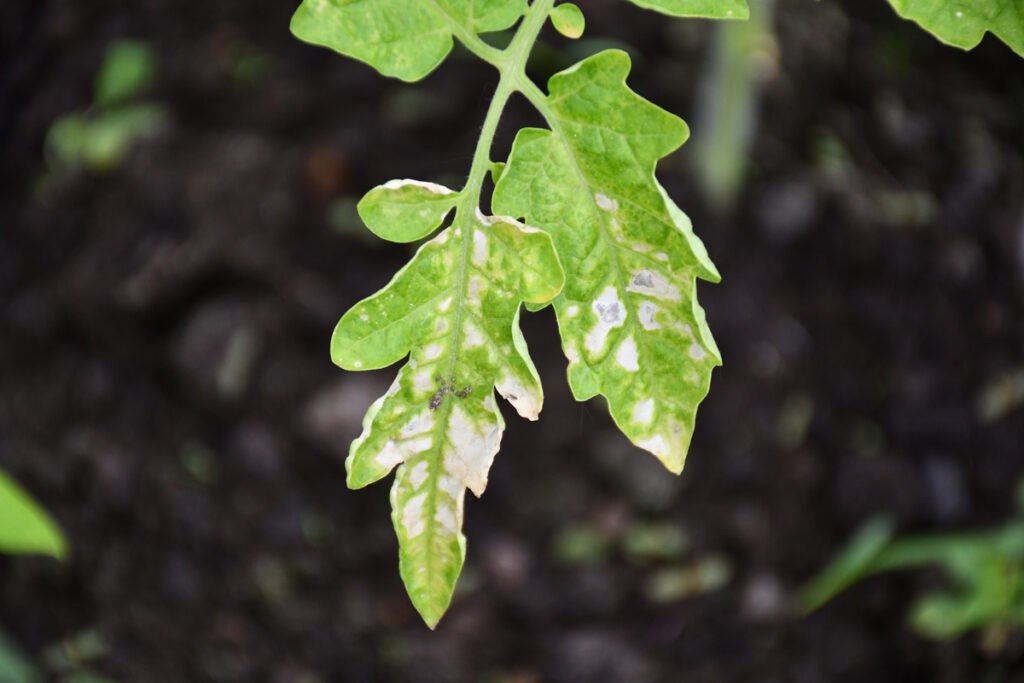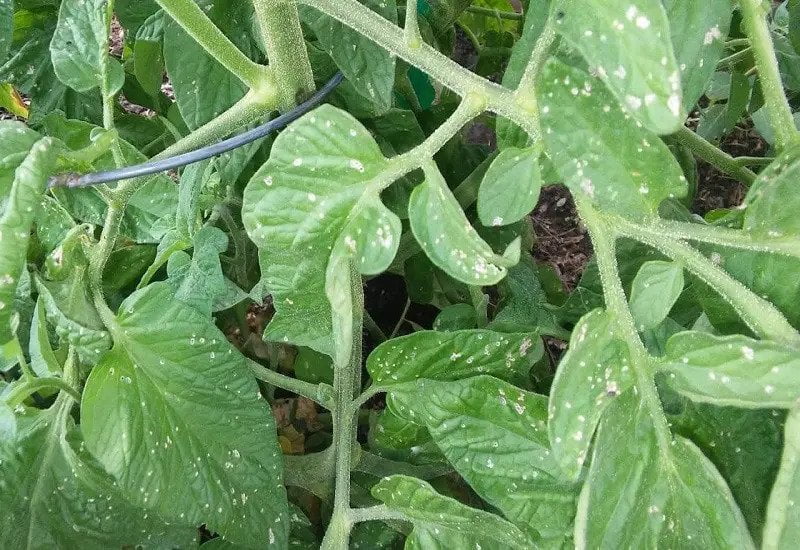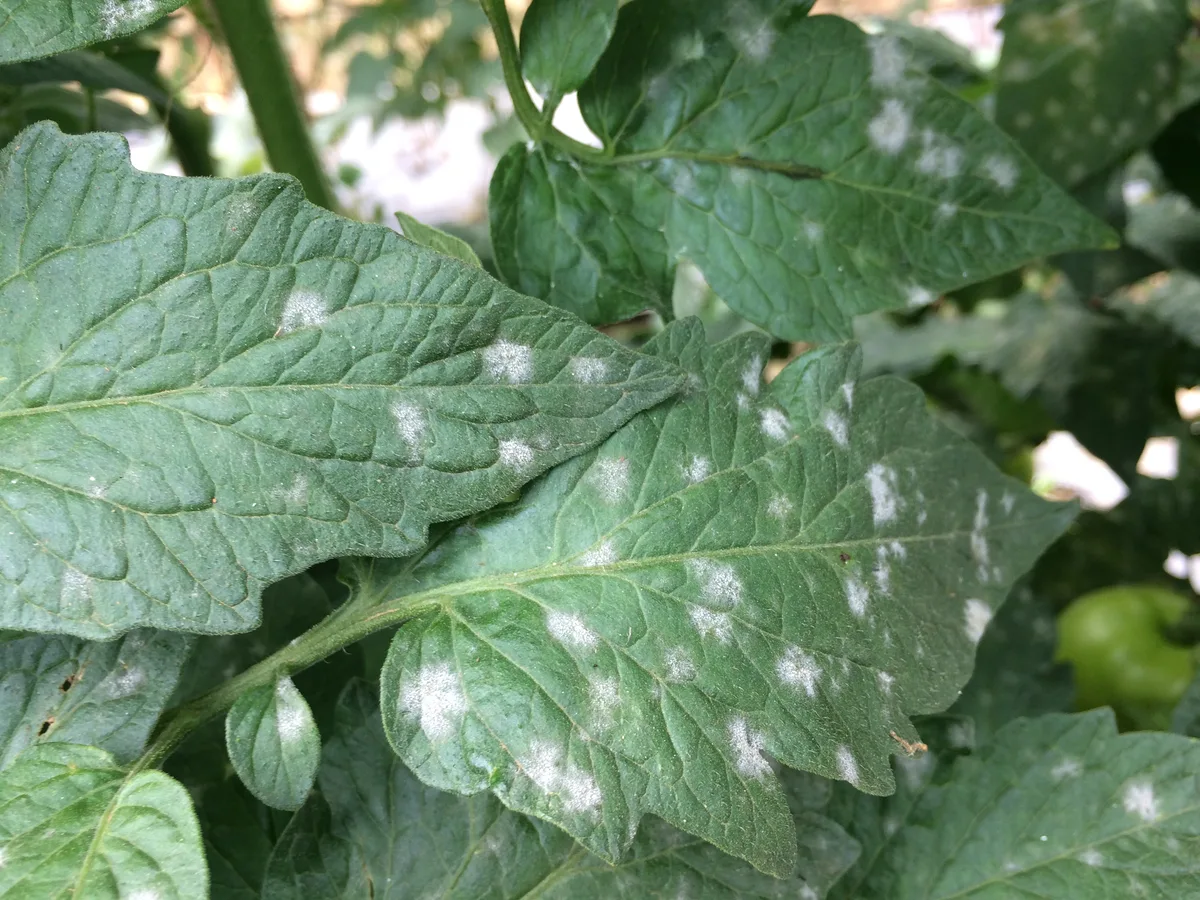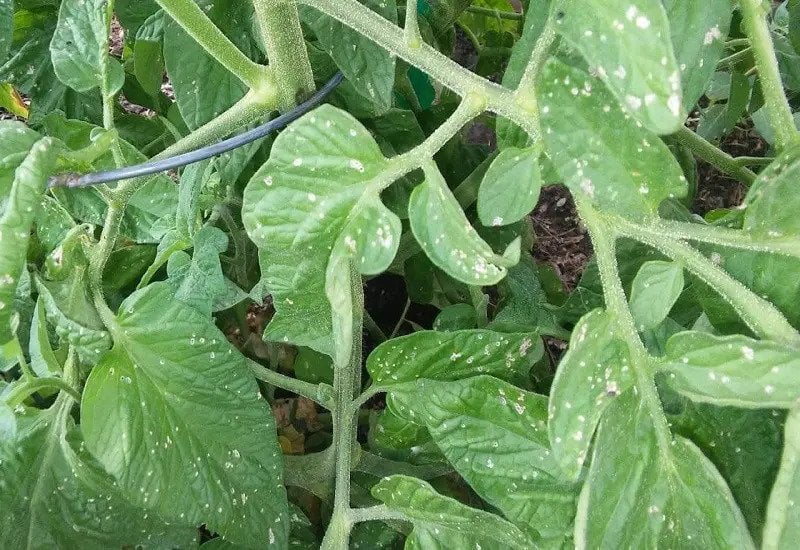In this article, the focus is on an intriguing and concerning phenomenon observed in tomato plants – the presence of white spots. These spots, which have sparked the curiosity of researchers and garden enthusiasts alike, have been found to affect the health and productivity of the plants. By examining the causes and potential implications of this unusual occurrence, this article aims to shed light on the impact of white spots on tomato plants and provide insights into possible remedies for growers and farmers.

Common Causes of White Spots on Tomato Plants
Tomato plants with white spots can be a cause for concern for gardeners and farmers alike. These white spots can indicate various problems and conditions that can affect the health and productivity of the plants. Understanding the common causes of white spots on tomato plants is crucial in order to identify and address the underlying issues effectively. In this article, we will explore some of the common causes of white spots on tomato plants, including powdery mildew, late blight, whitefly infestation, sunscald, and nutritional deficiencies. Additionally, we will discuss how to identify and treat each of these issues, as well as other potential causes and preventive measures that can be taken to maintain the health of tomato plants.
Powdery Mildew
Powdery mildew is a fungal disease that commonly affects tomato plants. It is characterized by the appearance of white or grayish powdery spots on the leaves, stems, and even fruit of the plant. The fungus responsible for powdery mildew thrives in warm and humid conditions, making it a prevalent problem in many regions.
Late Blight
Late blight is another fungal disease that can cause white spots on tomato plants. It is caused by the pathogen Phytophthora infestans and can be particularly devastating to tomato crops. Late blight typically starts as dark, water-soaked lesions on the leaves, which later develop into large, whitish spots. As the disease progresses, the spots may turn brown or black, displaying a somewhat fuzzy appearance.
Whitefly Infestation
Whiteflies are tiny insects that can infest tomato plants and cause white spots on the foliage. These pests feed on the sap of the plants, leaving behind a sticky substance called honeydew. The honeydew can attract a black sooty mold, which can further contribute to the appearance of white spots on the leaves. Whiteflies are notorious for their rapid reproduction rates, making control and prevention crucial in managing this infestation.
Sunscald
Sunscald is a physiological disorder that can cause white spots on tomato plants. It typically occurs when the fruit is exposed to excessive sunlight, particularly during hot summer days. The intense heat can cause damage to the skin of the fruit, resulting in the formation of white or yellowish spots. Sunscald is more commonly observed on green or immature tomatoes, but it can also affect mature ones.
Nutritional Deficiencies
Nutritional deficiencies can also lead to the development of white spots on tomato plants. Inadequate levels of essential nutrients, such as calcium, can affect the cellular structure and function of the plants, resulting in various symptoms, including the appearance of white spots. It is important to maintain a balanced nutrient supply to ensure the optimal growth and productivity of tomato plants.
Identifying and Treating Powdery Mildew
Description of Powdery Mildew
Powdery mildew is a fungal disease caused by different species of the fungal pathogens belonging to the Erysiphales order. These pathogens thrive in warm, dry environments and can infect various plant species, including tomato plants. The characteristic symptom of powdery mildew is the development of white or grayish powdery patches on the surfaces of leaves, stems, and sometimes fruit.
Symptoms of Powdery Mildew on Tomato Plants
In tomato plants, the symptoms of powdery mildew initially appear as small, circular white spots on the upper surface of the leaves. These spots gradually enlarge and merge together, forming a powdery layer of fungal spores. As the disease progresses, the affected leaves may become distorted, shriveled, and turn yellow. In severe cases, the powdery mildew can also affect the stems and fruit of the tomato plant.
Prevention and Treatment of Powdery Mildew
Preventing powdery mildew starts with creating unfavorable conditions for the fungus to thrive. This includes ensuring proper air circulation around the plants, avoiding excessive nitrogen fertilization, and avoiding overhead watering, as these practices can create a humid environment favorable for the growth of powdery mildew. In terms of treatment, various fungicides are available that can help control the disease. It is important to choose an appropriate fungicide and follow the instructions carefully to ensure effective control of powdery mildew.

Understanding and Managing Late Blight
Introduction to Late Blight
Late blight, caused by the pathogen Phytophthora infestans, is a devastating disease that affects tomatoes and other plants in the nightshade family. This destructive fungal pathogen can spread rapidly and cause significant damage to tomato crops. Understanding the symptoms and methods of control and prevention is crucial in effectively managing late blight.
Symptoms of Late Blight on Tomato Plants
The symptoms of late blight on tomato plants initially appear as dark, water-soaked lesions on the leaves, typically starting from the lower parts of the plant. As the disease progresses, these lesions may enlarge and develop a whitish-gray, fuzzy appearance. The affected leaves may eventually wither and die. In humid conditions, a white, mold-like growth may also be observed on the underside of the leaves.
Control and Prevention of Late Blight
Controlling late blight requires a comprehensive approach that includes removing and destroying infected plants, ensuring proper sanitation practices, and the use of fungicides. Fungicides containing active ingredients such as copper can be effective in preventing the spread and development of late blight. Additionally, practicing crop rotation and selecting resistant tomato varieties can help reduce the risk of late blight infection.
Dealing with Whitefly Infestation
Introduction to Whiteflies
Whiteflies are small, flying insects that belong to the family Aleyrodidae. These tiny pests feed on the sap of tomato plants and can cause significant damage if left untreated. Whiteflies are commonly found on the undersides of leaves and can be difficult to detect due to their small size and ability to quickly move away when disturbed.
Signs of Whitefly Infestation on Tomato Plants
Signs of a whitefly infestation on tomato plants include the presence of tiny white, winged insects, particularly on the undersides of leaves. A closer examination may reveal the presence of whitefly eggs, which are small, oval-shaped, and typically found in clusters. The feeding activities of whiteflies can cause yellowing of leaves, stunted growth, and the appearance of white spots on the foliage.
Methods to Control Whitefly Infestation
Controlling whitefly infestations can be challenging, but several methods can help manage and reduce their populations. These include physical removal of the insects by using a strong stream of water, introducing natural enemies like ladybugs and parasitic wasps, and using insecticidal soaps or oils. It is important to monitor the population levels of whiteflies regularly and take action as soon as signs of infestation are observed to prevent further damage.

Preventing and Correcting Sunscald on Tomato Plants
Overview of Sunscald
Sunscald is a physiological disorder that occurs when tomato plants are exposed to excessive sunlight and heat. The intense heat can cause damage to the skin of the fruit, leading to the development of white or yellowish spots. Sunscald is more commonly observed on green or immature tomatoes, as they have less protection against direct sunlight compared to mature fruits.
Identifying Sunscald on Tomato Plants
Sunscald on tomato plants is characterized by the appearance of white or yellowish spots on the exposed areas of the fruit or leaves. These spots may enlarge and become papery or dry in texture over time. In severe cases, the affected areas can become brown or develop a leathery texture. It is important to differentiate sunscald from other diseases or disorders that may cause similar symptoms, such as fungal infections or nutritional deficiencies.
Preventive Measures for Sunscald
Preventing sunscald starts with providing proper shading and protection for the tomato plants. This can be achieved by using shade cloth, mulching the soil around the plants to reduce heat reflection, and ensuring adequate spacing between plants for proper air circulation. Additionally, selecting tomato varieties with a natural resistance to sunscald can help minimize the risk of this disorder.
Treating Sunscald
Treating sunscald primarily involves removing the affected fruits or leaves from the plant. This helps prevent further damage and reduces the risk of secondary infections. It is important to harvest ripe tomatoes promptly to avoid prolonged exposure to direct sunlight. Proper handling and storage of harvested tomatoes can also help prevent sunscald during post-harvest stages.
Addressing Nutritional Deficiencies in Tomato Plants
Common Nutritional Deficiencies in Tomato Plants
Tomato plants require a well-rounded supply of essential nutrients for optimal growth and productivity. However, various factors, including imbalanced soil composition and improper fertilization practices, can lead to nutrient deficiencies in tomato plants. Some common nutritional deficiencies observed in tomato plants include calcium deficiency, nitrogen deficiency, and magnesium deficiency.
Symptoms of Nutritional Deficiencies
Nutritional deficiencies in tomato plants can manifest in different ways, including the appearance of white spots on the leaves. A calcium deficiency, for example, can lead to the development of blossom end rot, which presents as dark, sunken spots on the bottom of the fruit. Nitrogen deficiency may cause yellowing of the leaves, stunted growth, and reduced fruit production. Magnesium deficiency can lead to interveinal chlorosis, where the veins of the leaves remain green while the areas in between turn yellow.
Fertilization and Soil Amendments for Nutritional Balance
Addressing nutritional deficiencies in tomato plants requires a multifaceted approach. Conducting a soil test can help determine the specific nutrient deficiencies and guide the appropriate fertilization practices. The application of organic matter, such as compost or well-rotted manure, can help improve the overall fertility and nutrient availability of the soil. Additionally, targeted fertilization with specific nutrient-rich amendments, such as calcium or nitrogen, can help correct and prevent nutrient deficiencies in tomato plants.

Other Potential Causes of White Spots on Tomato Plants
Fungal Diseases
Aside from powdery mildew and late blight, various other fungal diseases can cause white spots on tomato plants. Diseases such as early blight, septoria leaf spot, and alternaria leaf spot can all lead to the development of white spots on the foliage. These diseases are typically characterized by the formation of lesions accompanied by discoloration and wilting of the affected plant parts.
Viral Infections
Viral infections can also be responsible for the appearance of white spots on tomato plants. Viruses such as tomato yellow leaf curl virus and cucumber mosaic virus can cause mottled or mosaic patterns of discoloration on the leaves, which may resemble white spots. Other symptoms of viral infections may include stunted growth, distorted leaves, and reduced fruit quality and yield.
Pesticide Residue
The use of certain pesticides, particularly those containing sulfur or copper, can potentially leave behind residue on tomato plants, resulting in the appearance of white spots. It is important to follow the instructions provided with the pesticide and adhere to recommended waiting periods before harvest to minimize the risk of residue-related white spots.
Environmental Factors
Various environmental factors can contribute to the development of white spots on tomato plants. Excessive heat, particularly during periods of drought, can cause heat stress and lead to the appearance of white spots or blemishes on the fruit. In addition, exposure to intense sunlight, high humidity, or extreme weather conditions can also affect plant health and contribute to the formation of white spots.
Preventive Measures for White Spots on Tomato Plants
Maintaining Good Plant Health
Maintaining overall plant health is crucial in preventing the occurrence of white spots on tomato plants. This includes providing optimal growing conditions, such as adequate sunlight, proper irrigation, and well-drained, nutrient-rich soil. Regularly monitoring and addressing any signs of pests or diseases can also help prevent the development of white spots.
Proper Cultural Practices
Implementing proper cultural practices can help minimize the risk of white spots on tomato plants. This includes practicing crop rotation, which helps reduce the buildup of pests and diseases in the soil. Proper spacing between plants promotes good air circulation, reducing the risk of fungal infections. Removing and destroying infected plant material promptly can prevent the spread of diseases and pests to other plants.
Regular Inspection for Pests and Diseases
Regularly inspecting tomato plants for pests and diseases is essential in identifying early signs of problems, including the development of white spots. Monitoring the undersides of leaves, examining fruit for any abnormalities, and staying informed about common pests and diseases in your area can help you take appropriate action at the right time.
Crop Rotation
Crop rotation is an effective preventive measure for white spots and various other diseases and pests. By rotating tomato plants with different plant families, the risk of buildup of specific pathogens or pest populations can be significantly reduced. This practice disrupts the life cycle of pests and pathogens, helping to maintain the health and productivity of tomato plants.

Conclusion
White spots on tomato plants can be caused by a variety of factors, including fungal diseases like powdery mildew and late blight, whitefly infestation, sunscald, nutritional deficiencies, and other potential causes such as viral infections, pesticide residue, and environmental factors. Proper identification and understanding of these causes, along with implementing effective control and prevention measures, are essential in maintaining the health and productivity of tomato plants. By practicing good plant health management, implementing cultural practices, regularly inspecting for pests and diseases, and employing strategies like crop rotation, gardeners and farmers can minimize the risk of white spots and ensure the successful cultivation of tomato plants.



